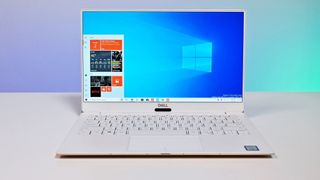Microsoft compels Windows 10 users to upgrade to Windows 11 with annoying full-screen banners again
It's time for Microsoft's 'weekly' reminder, asking 'Windows 10 users to upgrade to Windows 11.

What you need to know
- Microsoft is using full-screen banners and reminders to try and get Windows 10 users to upgrade to Windows 11 before its imminent end-of-support, slated for October 14, 2025.
- Users with supported devices are being asked to upgrade to Windows 11 instantly or schedule the update for later.
- Those with unsupported devices are furnished with contextual information, including learning more about Windows 10's end-of-support.
- Microsoft previously launched a new webpage to serve as a subtle reminder about Windows 10's upcoming death and even touted Windows 11 as a great resource for celebrity gossip, stocks, and weather updates.
Microsoft wants Windows 10 users to upgrade to Windows 11, and it's clearly not shy about it. In the past few months, we've seen the Redmond giant use several tactics in a bid to get users to transition to its AI-powered OS. You might remember Windows 10 users receiving multi-panel pop-up ads, taking up the PC's entire screen real estate — recommending a Windows 11 upgrade.
Perhaps more interestingly and strange, Microsoft's latest gambit touts Windows 11 as a great resource for staying updated with celebrity gossip, stocks, and weather updates. According to StatCounter's latest report, Windows 11 still lags miles behind Windows 10's dominant 68.36% market share worldwide.
And as it now seems, Microsoft is back to its old tricks. According to Windows Latest, the tech giant is using full-screen banner ads to push Windows 10 to Windows 11. This time, the ads aren't just exclusive to Windows 10 users with devices that meet Microsoft's stringent system requirements for Windows 11. Users with unsupported devices are getting these seemingly annoying ads, too.
The outlet reports the ad popped up after installing the Windows 10 May 2024 Update. The banner features "A new journey with Windows" which is essentially a message from Microsoft thanking Windows 10 users for being loyal customers and a reminder of Windows 10's imminent end -of-support.

Microsoft also leverages this opportunity to remind users that their devices aren't Windows 11-ready, and provides contextual information, including learning more about Windows 10's end-of-support, the option to get a reminder about the issue later, and more. There's also a link that directs you to a page which compares Windows 11 and Windows 10 side-by-side, presenting a compelling case why you should upgrade.
However, if you're still running Windows 10 on a Windows 11-ready PC, you'll be requested to upgrade to the AI-baked OS by scheduling the update or installing it immediately by clicking the Get it button.
There's also a Keep Windows 10 option tucked away at the bottom of the page allowing you to continue running Windows 10 on your device, as it will continue to receive important security updates till October 14, 2025.
Get the Windows Central Newsletter
All the latest news, reviews, and guides for Windows and Xbox diehards.
Despite selecting the Keep Windows 10 options, Microsoft reportedly tries to convince users to upgrade to Windows 11 using four additional banners. It's barely been two weeks since Microsoft issued a subtle reminder on Windows 10's imminent end-of-support date, but it seems users are reluctant about making the major transition.

Kevin Okemwa is a seasoned tech journalist based in Nairobi, Kenya with lots of experience covering the latest trends and developments in the industry at Windows Central. With a passion for innovation and a keen eye for detail, he has written for leading publications such as OnMSFT, MakeUseOf, and Windows Report, providing insightful analysis and breaking news on everything revolving around the Microsoft ecosystem. You'll also catch him occasionally contributing at iMore about Apple and AI. While AFK and not busy following the ever-emerging trends in tech, you can find him exploring the world or listening to music.
-
K Shan Annoying people to use a product, is good way to get people to not even try it. I don't get why they don't just do the same thing they did with Vista and 8. Take an update ,roll back the start menu to be more like the old version, and start marketing it as the next version of Windows.Reply